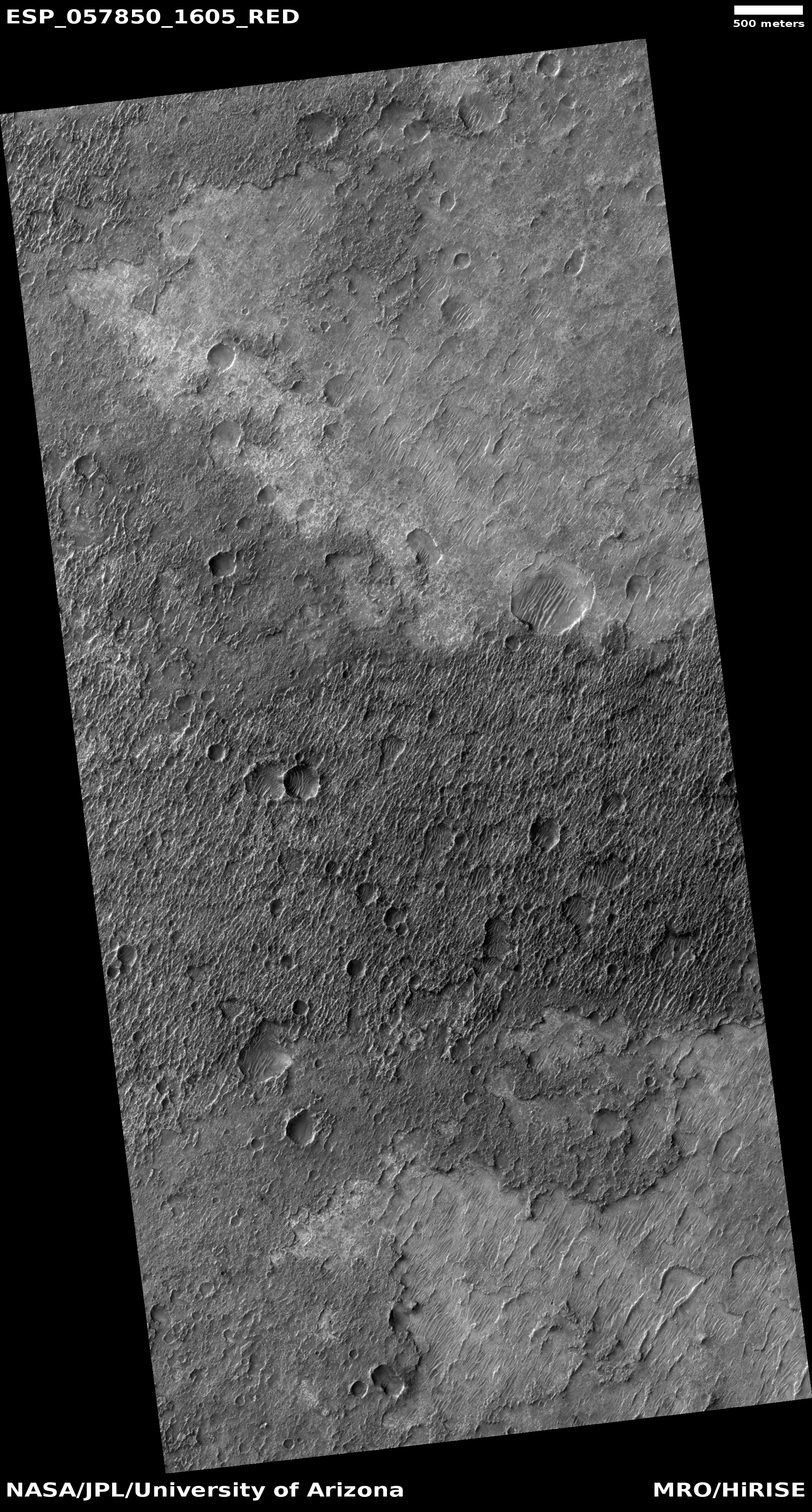
Posted on 02/11/2019 8:15:22 AM PST by Red Badger
Cool image time! The picture on the right, cropped and reduced to post here, was part of the January image release from the high resolution camera of Mars Reconnaissance Orbiter (MRO). It shows an area in the Martian southern highlands where the surface suddenly gets darker, for no obvious reason.
The uncaptioned release image is titled “Dark-Toned Ridge at Junction with Dark-Toned Plain.” From the image itself it is hard to understand this title. In the full image the darkest terrain is a strip in the center, with slightly lighter dark terrain on either side, and the lightest terrain to the north or south. The photograph however does not show us how far this dark terrain extends to the west or east.
Two Mars Odyssey image strips of less resolution, here and here, show that this region is filled with several large patches of dark-tone surface. With this particular patch the center dark ridge is surrounded by that slightly lighter dark area.
MRO itself has not taken many images of this region, as shown in the overview image below. The red rectangles indicate MRO’s high resolution photographs, with this image indicated by the cross. At this low resolution this region seems somewhat nondescript. The Mars Odyssey image strips show that there many features here, but with little significant relief.
Location of dark toned ridge
At high resolution there does not appear to be much difference between the darker and lighter areas. The lighter areas in general seem less rough and at a slightly lower elevation, but both areas are dominated by ridges and dunes trending southwest-to-northeast.
Why is this slightly higher region darker? Let’s assume that this darker material was a lava flow overlaying the surface. Over eons wind erosion, trending southwest-to-northwest, roughly eroded both it and the lower layers around it, leaving behind this rough corroded terrain. The different make-up of the darker material allows it to erode in a rougher manner.
While possibly correct, I would not bet much money on this guess. It is not clear it is lava. It is not clear that it is a flow. It does not explain why there are two areas of different darkness. And it certainly not clear what the make-up of any of this stuff is.
This is simply another cool mystery on the Martian surface.
Looks like that to me too. Those are definitely dune ripples, even in the bottom of the craters.
Oil-shale deposit.
Looks similar to the vinyl tile the wife and I put down in the bathroom last month.
Is it ‘green’?.........................
Wormsign....................
Spice..................................
The uncaptioned release image is titled "Dark-Toned Ridge at Junction with Dark-Toned Plain."
I didn't know NASA had poets on the staff. ;^) Thanks Red Badger.
Mars wearing black face?

Some of those craters are 300-500 meters wide.......................
"MARS WEARS BLACK FACE!!!"
It’s there in the darker area too, you just have to look close. Look in the left section toward the top of the dark area, where two medium sized craters overlap. Just below those and to the right you can see it, and in the bottom of several craters, then once you see what to loo for, it becomes more visible in other areas.
Also, I notice some craters have no dune effect. Newer ones not old enough yet to show this dune effect?
But wait...I may be wrong here but I thought Mars didn’t have an atmosphere, so where does the wind come from? This definitely looks like the work of either wind or water, and water has been long gone for eons, or am I wrong and Mars does have an atmosphere of some sort?
I do notice it in some of the dark craters, but of course those would also be a lower elevation and shielded from the wind at least a bit.
Mars does have an atmosphere, it is thinner than Earths, but it definitely has one, and weather. There are giant dust storms there for months at a time.
Right you are, it’s been a while and I forgot Mars does have a thin atmosphere, and I’ve seen the results of a dust storm through a telescope. (Can’t have a dust storm without an atmosphere) The huge dust storms obscure almost all of the detail you can see under normal viewing conditions. When Mars was at closest approach several years ago it was one of the first things I looked at when I first got my 6 inch Orion scope. Saturn too that year, both close as they get. During a dust storm, Mars was just an orange blob. (No Trump jokes please...lol)
I do have to argue the comment that the craters would be shielded from wind, it would still wrap around, so to speak, similar to what causes lift in an airplane wing, and get some wind, but less of it. The dunes in craters attest to that.
The craters without dunes would be newer ones, haven’t had time to develop dunes yet.
Then again I’m no professional, mostly guessing.
It is interesting to note that most of these are smaller craters, no more than 500 meters across or so, when we see some on the moon that are miles across. I realize this is a small area, but even with a good scope no huge craters are visible that I remember. I can only guess, but was the atmosphere thick enough at some point to burn up meteors same as here on Earth? The same objects floating around in space were there but none or few hit Mars? Especially when the asteroid belt is between Mars and Jupiter so Mars is the closer target? Interesting...

Disclaimer: Opinions posted on Free Republic are those of the individual posters and do not necessarily represent the opinion of Free Republic or its management. All materials posted herein are protected by copyright law and the exemption for fair use of copyrighted works.